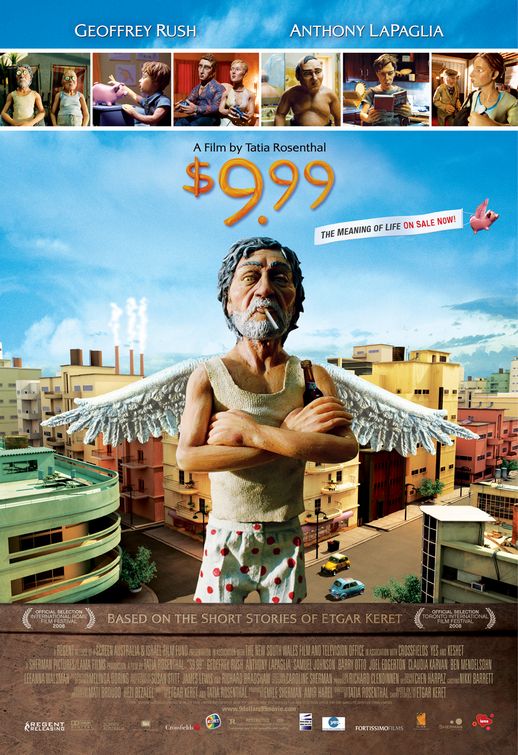As an Israeli-Australian collaboration, I’m not sure that $9.99 qualifies as an Australian movie. If it did, I would have no hesitation in declaring this another brilliant offering – if not the most brilliant – in a year that is now, without doubt, a great one for Aussie cinema.
This stop-motion claymation movie opens with an encounter between a jaded-looking suited businessman and an articulate derelict who approaches him for a light. The businessman accedes, but baulks at the follow-up request for a cigarette, realising he has been played. A Socratic-style exchange of dialogue follows, culminating in the vagabond holding a gun against his temple, threatening to kill himself if he is denied a cigarette, while the businessman frets over being manipulated and decides that he is not responsible for another’s suicidal action. His neat conclusion is thrown dramatically into doubt by what happens next. And what happens next is not as it seems at first…
This intriguing beginning promises a lot, and boy does the rest of the movie deliver!
The sheer imaginative scope of this work is something to behold. Technically, $9.99 is a creative feat of some magnitude. Stop-motion claymation, puppetry and CGI is blended to create a visually arresting – quite magical, in fact – cinematic experience, delivering us into a world of urban isolation that is surreal, yet grounded in familiar conflicts, existential dilemmas and quests for meaning that are all too recognisable as inescapable aspects of 21st century reality.
As marvellous as the animation is, the real strength of the movie is in the writing. It is clear from the outset that a fine literary sensibility – rare in movies, I would submit – is at work here. I knew nothing of the background of the writers until my post-viewing research, but it came as no surprise to learn that an acclaimed author is behind $9.99 – Israeli writer Etgar Keret, who shares the writing credits with director Tatia Rosenthal.
The plot, drawn from some of Keret’s short stories, is multi-stranded and complex, moving along via dialogue that is sharp and tight, and informed by a sparkling intelligence. Forget about predicting what will come next. Expect a left turn, it’ll go right; anticipate a twist and you’ll get it, but not how you expect.
Stunning imagistic metaphor and symbolism is used to articulate the otherwise inexpressible, much as the best poetry does, while opening the way for individual interpretation.
An inanely grinning piggy bank, for example, which a father presents to his child purportedly to teach him responsibility and a work ethic (so he doesn’t “grow up to become a criminal”) spoke to me of the absurdity of the capitalist system we take for granted, and in which we are mired.
How many of us live the great bulk of our lives as zombies performing demeaning, humdrum tasks that give us no satisfaction and no sense of purpose other than tantalising us with the possibility of acquiring enough bucks to free ourselves from our bondage at some happy time in the mirage that is the future? Some of us wake up to this ruse, yet we continue to play the game, feeding the pig with coins so that when it is finally sated, we may take a hammer to it and smash it to smithereens, take our spoils and…start again with another pig. Rage against the machine though we might, we are stuck in it – we are part of it, doomed like Sisyphus to our laborious routine.
The child character, however, comes to see the pig as a pet. As his attachment grows, the coins he feeds it on his father’s instructions become a death sentence. When its belly is full, he resists his father’s entreaties to break it open and smuggles it to a secret place in a nearby park, where it may live out its piggy bank life in grinning safety, hidden in the grass away from plundering hammers. O the eyes of innocents…
Then there is the character who will do anything to please the narcissistic supermodel he falls for. Bit by bit he surrenders his identity until he becomes just another of the weird-looking cushions arranged around her apartment – shapeless blobs that yield to fit her body contours when she sits on them.
The title of the movie refers to the price of a book that purports to reveal the meaning of life. Dave Peck, 28 years old, unemployed, and still living at home with his father and brother, buys it, but finds that no one will listen when he tries to impart its contents. So he orders another book on “effective communication” from the same publisher, which turns out to be no longer available. Instead, he is sent another: How To Swim Like A Dolphin. And that’s what he and his father end up doing, threading their ways joyfully through the waters of a city lake, alive with freedom and, finally, a sense of meaning!
Why try to pin that image down with analysis? It is beautiful, poetic, detached from the restrictions of the rational, absurd – but no more so, perhaps, than the ways many of us fill our days. It says what it says, and that is plenty…and this is true of the entire movie, which works as enthralling entertainment, yet is so packed with thought-provoking layers of meaning, so full of stunning imagery and visual metaphor, that it would take several viewings to do it justice.
If, like me, you tend to steer clear of animation movies, put aside your expectations and prejudices for this one. A creative and philosophical tour de force.
For other Boomtown Rap movie reviews, see Movie Review Archives
